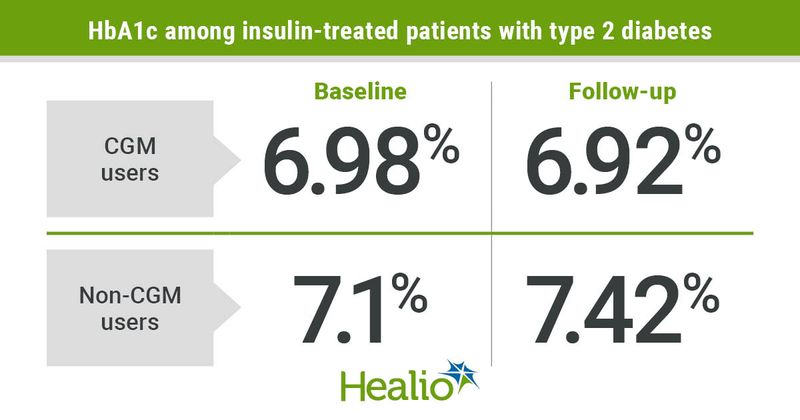CGM prevents glycemic deterioration in insulin-treated adults with type 2 diabetes
Adults with type 2 diabetes treated with insulin who initiate continuous glucose monitoring better maintain their HbA1c compared with those who do not use CGM, according to study findings.
“CGM initiation was associated with a net improvement in glycemic control (0.3 points lower HbA1c) in this observational cohort of insulin-treated patients with type 2 diabetes who used self-monitoring of blood glucose, had HbA1c < 8%, and no recent severe hypoglycemia,” Andrew J. Karter, PhD, senior research scientist at Kaiser Permanente Northern California’s Division of Research in Oakland, California, and colleagues wrote in a study published in Diabetes Technology & Therapeutics. “This net benefit was largely attributable to the significant deterioration of glycemic control among non-initiators rather than improvement in glycemic control among CGM initiators.”

Researchers conducted a retrospective cohort study of 17,422 adults with type 2 diabetes treated with insulin who used SMBG at baseline, had an HbA1c of less than 8% and no recent cases of severe hypoglycemia. Participants were classified as CGM initiators if they started CGM from 2015 to 2019 (n = 149). The remaining 17,273 patients who did not use CGM served as a reference group. Changes in HbA1c and severe hypoglycemia rates were compared from the 12 months before CGM initiation to the 12 months after initiation. For the reference group, changes in HbA1c and severe hypoglycemia were calculated using a randomly assigned date as baseline.
Among those who started CGM, HbA1c declined from 6.98% at baseline to 6.92% after CGM initiation. Among those who did not use CGM, HbA1c increased from 7.1% to 7.42%. After using overlap weighting and adjusting for covariates, the CGM group had a 0.3 percentage point greater improvement in HbA1c compared with the reference group (95% CI, –0.5 to –0.1; P = .004).
The prevalence of participants with an HbA1c of less than 7% increased among CGM users from 40.3% before initiation to 53.7% after initiation. Those who did not use CGM had a decline in the percentage of participants with HbA1c of less than 7% from 35.1% to 33.2%. There was no significant difference in the prevalence of patients with an HbA1c of less than 8% between the two groups. The CGM group had fewer patients with an HbA1c higher than 9% compared with the reference group (1.4% vs. 6.6%; P = .009).
“CGM initiation may have enabled patients to better manage their insulin and health behaviors than SMBG alone,” the researchers wrote. “Additional observational studies from other health care settings or randomized trials of CGM in well-controlled patients with type 2 diabetes should be conducted to confirm these observational findings.”
